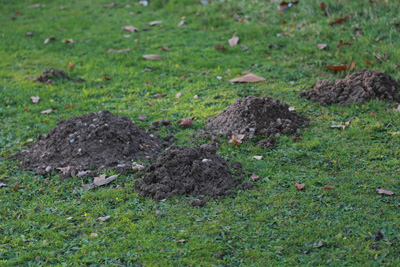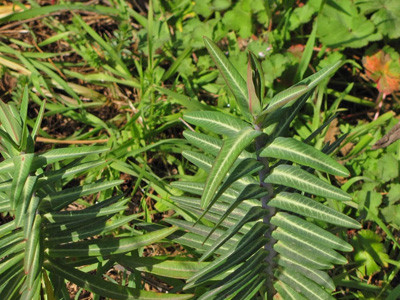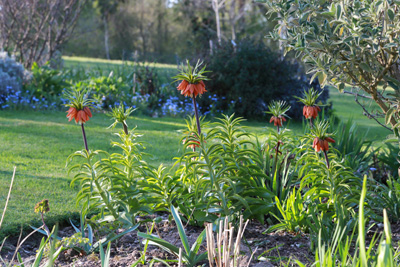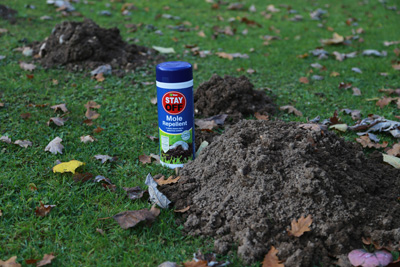How to deter moles
How to deter moles
 Moles are such appealing creatures it is hard to believe that these tiny, innocent looking animals can cause such havoc in the garden as they burrow and forage for food. The results of their activity seem to appear overnight as the lawn erupts in a range of brown molehills: piles of fine soil thrown to the surface as they make their burrows beneath the surface. Molehills are not as obvious in beds and borders, but moles can be just as disruptive here, disturbing the ground and the roots of your precious plants. Harming these little creatures may be unthinkable, but how do you deter moles and make them go elsewhere?
Moles are such appealing creatures it is hard to believe that these tiny, innocent looking animals can cause such havoc in the garden as they burrow and forage for food. The results of their activity seem to appear overnight as the lawn erupts in a range of brown molehills: piles of fine soil thrown to the surface as they make their burrows beneath the surface. Molehills are not as obvious in beds and borders, but moles can be just as disruptive here, disturbing the ground and the roots of your precious plants. Harming these little creatures may be unthinkable, but how do you deter moles and make them go elsewhere?
How many moles are there?
Seeing a mass of molehills does not mean you have a plague of these little creatures. Moles do not get along with each other and are generally solitary animals, except in the mating season. There are never more than three to five moles on an acre of land, so in most gardens it is rare for there to be more than one.
A mole can tunnel around five metres in an hour. The surface tunnels are not far below the surface, therefore the ground where they are active may feel soft and spongy. The main tunnels are more than one metre down.
Moles do not hibernate. They are usually nearer the surface in winter and deeper in summer. They love moist soil where worms are active, which is why they suddenly appear when the soil becomes cool, and moist in late autumn. During the summer months areas of the garden that are regularly watered are more prone to mole activity: cease watering and the moles may go away.
Plants that deter moles
 There are a number of plants which are reputed to keep moles away. Daffodils and marigolds reputedly repel the animals. Daffodil bulbs are toxic, therefore moles probably avoid their roots. Marigolds are aromatic and contain natural pyrethrins, they therefore are likely to repel the soil dwelling bugs that moles feed upon.
There are a number of plants which are reputed to keep moles away. Daffodils and marigolds reputedly repel the animals. Daffodil bulbs are toxic, therefore moles probably avoid their roots. Marigolds are aromatic and contain natural pyrethrins, they therefore are likely to repel the soil dwelling bugs that moles feed upon.
The caper spurge, Euphorbia lathyris seeds freely producing a strange plant of architectural appearance. It is commonly known as mole plant because of its apparent ability to keep moles at bay. It seems to grow best on shallow chalk soils which are rarely favourite mole habitats.
The crown imperial, Fritillaria imperialis is a member of the lily family. Its large waxy bulbs smell strongly of fox and appear to repel moles.
 All of these could have some effect but their efficiency will be localized and results do depend on the size of your garden
All of these could have some effect but their efficiency will be localized and results do depend on the size of your garden
Repellents
Moles dislike activity and noise. Vibrating mole scarers that work off battery or solar power may be successful for a time, perhaps more so than musical greeting-cards stuck into mole hills. The latter has often been suggested in the past.
Moth balls in the mole tunnels, coffee grounds and castor oil mixed with cayenne pepper are all possible deterrents that some claim to work. However these are not all substances you would want to add to your soil.
For more certain results use Vitax Stay Off Mole Repellent. This is an entirely organic product that works by giving off a smell that moles associate with predator activity. A smell that is not unpleasant, or particularly noticeable to humans.
 Using a garden space you simply open up a tunnel between recent molehills and sprinkle in a little of the powder. You can also sprinkle it over the surface of the ground as a deterrent where moles have been previously active. It will not harm grass or plants, in fact it will break down releasing beneficial nitrogen into the ground.
Using a garden space you simply open up a tunnel between recent molehills and sprinkle in a little of the powder. You can also sprinkle it over the surface of the ground as a deterrent where moles have been previously active. It will not harm grass or plants, in fact it will break down releasing beneficial nitrogen into the ground.
What about the molehills?
Although the molehills are a nuisance they are a valuable source of finely graded soil. Shovel them up and use them to level out depressions in the lawn, top up beds and borders, or in raised beds on the vegetable garden. Mix with sharp sand and use as a lawn dressing, or with grass seed to patch up the lawn in spring. Every cloud has a silver lining!
Andy McIndoe for
Vitax Winter 2019
Find a stockist near you
To check if the product you require is in stock, please contact the retailer prior to visiting.
Your login details have been used by another user or machine. Login details can only be used once at any one time so you have therefore automatically been logged out. Please contact your sites administrator if you believe this other user or machine has unauthorised access.












